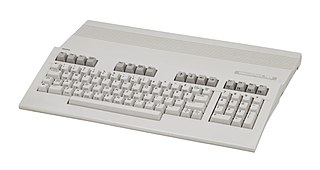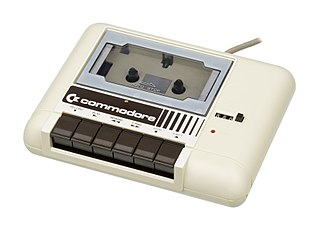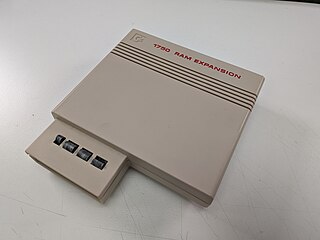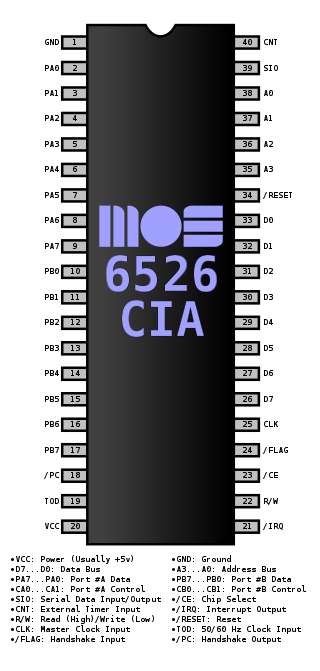
The Commodore 1541 is a floppy disk drive which was made by Commodore International for the Commodore 64 (C64), Commodore's most popular home computer. The best-known floppy disk drive for the C64, the 1541 is a single-sided 170-kilobyte drive for 5¼" disks. The 1541 directly followed the Commodore 1540.

The Commodore 1581 is a 3½-inch double-sided double-density floppy disk drive that was released by Commodore Business Machines (CBM) in 1987, primarily for its C64 and C128 home/personal computers. The drive stores 800 kilobytes using an MFM encoding but formats different from the MS-DOS, Amiga, and Mac Plus formats. With special software it's possible to read C1581 disks on an x86 PC system, and likewise, read MS-DOS and other formats of disks in the C1581, provided that the PC or other floppy handles the "720 kB" size format. This capability was most frequently used to read MS-DOS disks. The drive was released in the summer of 1987 and quickly became popular with bulletin board system (BBS) operators and other users.

The Commodore 1571 is Commodore's high-end 5¼" floppy disk drive, announced in the summer of 1985. With its double-sided drive mechanism, it has the ability to use double-sided, double-density (DS/DD) floppy disks, storing a total of 360 kB per floppy. It also implemented a "burst mode" that improved transfer speeds, helping address the very slow performance of previous Commodore drives.

The Commodore 128, also known as the C128, C-128, or C= 128, is the last 8-bit home computer that was commercially released by Commodore Business Machines (CBM). Introduced in January 1985 at the CES in Las Vegas, it appeared three years after its predecessor, the Commodore 64, the bestselling computer of the 1980s. Approximately 2.5 million C128s were sold during its four year production run.

The Commodore 1530 (C2N) Datasette, later also Datassette, is Commodore's dedicated magnetic-tape data storage device. Using compact cassettes as the storage medium, it provides inexpensive storage to Commodore's 8-bit computers, including the PET, VIC-20, and Commodore 64. A physically similar model, Commodore 1531, was made for the Commodore 16 and Plus/4 series computers.

The Commodore SX-64, also known as the Executive 64, or VIP-64 in Europe, is a portable, briefcase/suitcase-size "luggable" version of the popular Commodore 64 home computer and the first color portable computer.

The Commodore RAM Expansion Unit (REU) is a range of external RAM add-ons.
The Epyx Fast Load is a floppy disk fast loader cartridge made by American software company Epyx in 1984 for the Commodore 64 home computer. It was programmed by Epyx employee Scott Nelson, who was originally a programmer for Starpath and later designed the Epyx Vorpal fastloading system for the company's games.
The Commodore 64 amassed a large software library of nearly 10,000 commercial titles, covering most genres from games to business applications, and many others.
A bit nibbler, or nibbler, is a computer software program designed to copy data from a floppy disk one bit at a time. It functions at a very low level directly interacting with the disk drive hardware to override a copy protection scheme that the floppy disk's data may be stored in. In most cases the nibbler software still analyses the data on a byte level, only looking to the bit level when dealing with synchronization marks (syncs), zero-gaps and other sector & track headers. When possible, nibblers will work with the low-level data encoding format used by the disk system, being Group Coded Recording, Frequency Modulation, or Modified Frequency Modulation.

The 6526/8520 Complex Interface Adapter (CIA) was an integrated circuit made by MOS Technology. It served as an I/O port controller for the 6502 family of microprocessors, providing for parallel and serial I/O capabilities as well as timers and a Time-of-Day (TOD) clock. The device's most prominent use was in the Commodore 64 and Commodore 128(D), each of which included two CIA chips. The Commodore 1570 and Commodore 1571 floppy disk drives contained one CIA each. Furthermore, the Amiga home computers and the Commodore 1581 floppy disk drive employed a modified variant of the CIA circuit called 8520. 8520 is functionally equivalent to the 6526 except for the simplified TOD circuitry. Predecessor to CIA was PIA.

The Commodore 64 home computer used various external peripherals. Due to the backwards compatibility of the Commodore 128, most peripherals would also work on that system. There is also some compatibility with the VIC-20 and Commodore PET.

Simons' BASIC is an extension to BASIC 2.0 for the Commodore 64 home computer. Written by British programmer David Simons in 1983, who was 16 years old at the time, it was distributed by Commodore as a cartridge.

A fast loader is a software program for a home computer, such as the Commodore 64 or ZX Spectrum, that accelerates the speed of file loading from floppy disk or compact cassette.

The MSD Super Disk were a series of 5¼-inch floppy disk drives compatible to some degree with the Commodore 1541 disk drive. produced by Micro Systems Development for use with Commodore 8-bit home computers. Two different versions of the MSD Super Disk were available: the single-drive model, SD-1; and the dual-drive model, SD-2.
Amiga support and maintenance software performs service functions such as formatting media for a specific filesystem, diagnosing failures that occur on formatted media, data recovery after media failure, and installation of new software for the Amiga family of personal computers—as opposed to application software, which performs business, education, and recreation functions.
Happy drives are series of disk drive enhancements for the Atari 8-bit and Atari ST computer families produced by a small company called Happy Computers. Happy Computers is most noted for the add-in boards for the Atari 810 and Atari 1050 floppy disk drives, which achieved a tremendous speed improvement for reading and writing, and for the ability to backup floppies. Happy's products were among the most popular Atari computer add-ons. They were still in use and active in the aftermarket as of 2009.

The floppy disk is a data storage and transfer medium that was ubiquitous from the mid-1970s well into the 2000s. Besides the 3½-inch and 5¼-inch formats used in IBM PC compatible systems, or the 8-inch format that preceded them, many proprietary floppy disk formats were developed, either using a different disk design or special layout and encoding methods for the data held on the disk.
The Indus GT is a 5+1⁄4-inch floppy disk drive that was introduced by Indus Systems in 1983 for the Atari 8-bit computers. It was later released for the Apple II and Commodore 64. On the Atari, it was widely regarded as the best drive of the era, with the most features, highest performance, and even best industrial design. They were known for the advertising slogan, "Turn your Atari into a Ferrari." The GT was sold until around 1987, at which point the rights were sold to Logical Design Works and reintroduced as the LDW Super 2000, sold primarily into Poland, and the CA-2001, sold into the US.
'Commodore 64 disk/tape emulation and data transfer' comprises hardware and software for Commodore 64 disk & tape emulation and for data transfer between either the C64 computer, the Commodore 1541 disk drive or Commodore 1530 Datasette tape deck, and newer computers.













